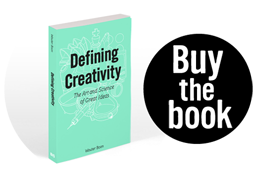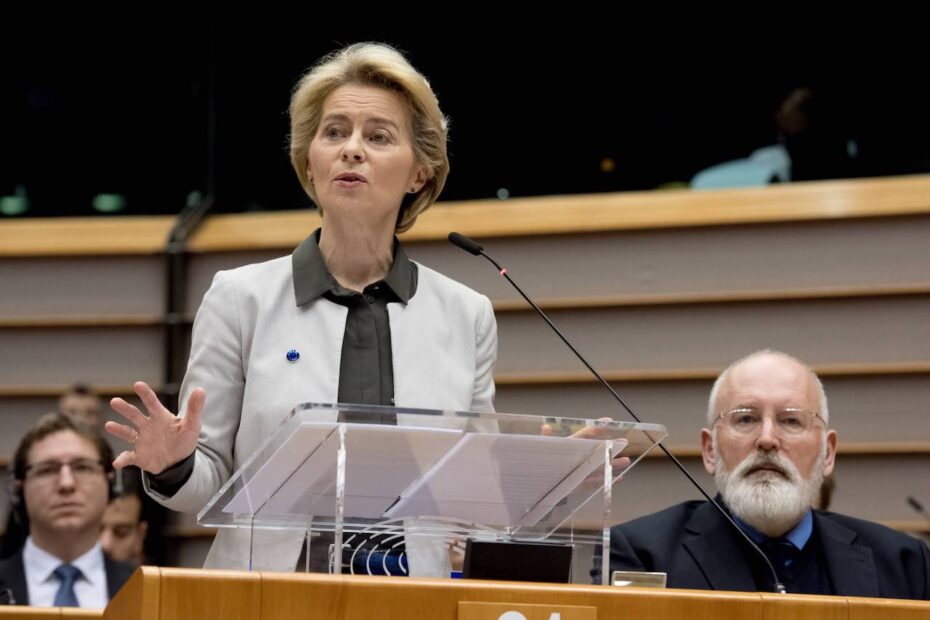Thinking like a startup
Last September Ursula von der Leyen, the brand-new President of the European Commission, announced an aspiring new course for Europe; to become the very first climate-neutral continent in the world by 2050. Frans Timmermans was appointed Executive Vice-President for the European Green Deal, which was presented last December and is to strongly decrease C02-emissions, increase the amount of trees and charging stations, prohibit non-recyclable packaging and insulate old buildings – to name a few goals and measures. Von der Leyen, fully aware of the ambitious nature of her plan, compared her Green Deal to John F. Kennedy’s ‘we choose to go to the moon’ announcement in 1962.
For the average European citizen, the EU is not much more than a technocratic super power that merely produces rules and calculations
I found it refreshing. It has been a long time since Brussels showed so much vision. For years the news about Europe predominantly has revolved around things like EU-members ignoring European legislation, a lack of budget discipline, refugees dividing the EU, and – last but not least – Great Britain leaving the EU. It is not surprising that for the average European citizen, the EU is not much more than a technocratic super power, merely producing rules and calculations.
Having a vision is one thing…
Dutch Prime Minister Mark Rutte once compared having a vision with an elephant obscuring your view. It not just shows that metaphors are not his forte. He also has a point. Dutch politics has a history of governing through compromises. The Dutch call this ‘polderen’, a word derived from the fact that a nation can only successfully live beneath sea level, if everyone is on board fighting the water. What Rutte really wants to say is that if you stubbornly cling to a vision, you paralyse the short-term decision-making. More broadly, you could say that in a democracy, finding compromises is the only way to get things done.
Radical innovation, however, requires uncompromising decisiveness, rather than polite negotiations. It is therefore better to leave the single-minded innovations to the startups of this world. The great advantage of a startup is that it can solely focus its energy on pursuing its vision. Someone like Elon Musk, for example, founded several groundbreaking start-ups aimed at neutralizing climate change. With SpaceX he tries to colonise Mars, and thus creates a planet B. With Hyperloop he has found a serious competitor for the airline industry. And with Tesla he has, in a relative short time, forced the entire car industry to believe in the future of the electric car.
Even if Von der Leyen is able to sell her vision with Kennedy’s charm, she still has to deal with 27 frogs in a wheelbarrow
The larger a startup grows, the more stakeholders influence its course, and the bigger the chance that the original vision gets watered down. The EU is clearly not a startup anymore. That’s why Jean-Cloud Juncker – Von der Leyen’s predecessor – called it a complex creature, consisting of 28 member-states, an equal amount of governments, more than 120 political parties and around 700 parliamentarians. Even if Von der Leyen is able to sell her vision with Kennedy’s charm, she still has to deal with 27 frogs (anticipating Brexit) in a wheelbarrow. Aligning them is nearly impossible. That’s why for the US it was relatively easy to execute on Kennedy’s moon-shot; it had one single government. Having a vision is one thing, but being able to execute on it is at least as important. Today, with an American President that doesn’t believe in climate change and an extremely polarized political arena, radical innovation will be difficult. But once a modern-day Kennedy takes over the Whitehouse, the US could much more easily roll out a Green Deal than the EU.
The EU’s startup climate
Given the EU’s complexity it has also been difficult to create a pan-European startup climate. Last year research institute Hurun published a report in which it listed the amount of startups around the world that are worth more than a billion US dollars. With 206 so called ‘unicorns’ China is heading the list, closely followed by the US with 203. The EU has 32. And when we anticipate the UK leaving the EU, our Union only has 19 unicorns. That is a substantial difference. It shows that having a large economy can be inducive to the level of innovation, but is not sufficient.
Europe has lost its leading position since the Renaissance, when it was easily the most innovative continent in the world
Europe has lost its leading position since the Renaissance, when it was easily the most innovative continent in the world. A period during which both the arts and sciences flourished. Michelangelo and Da Vinci celebrated the human body in all its beauty and Copernicus published the heliocentric theory, in which the Sun instead of the Earth suddenly became the centre of the Universe. The Renaissance can be concisely characterized as a period with an optimistic view on humanity, a hunger for knowledge, and high level of creativity.
In his book The Geography of Genius Eric Weiner visits cities around the world where creativity once flourished. Apart from 16th century Florence, he studies Athens of 450 BC, and Vienna of 1900. Athens is generally known as the cradle of our modern Western civilization. One of its most important inventions is democracy, the political system that revolves around a public debate that is accessible for everyone and the freedom of speech.
A tolerance toward dissenting views
Just like Florence, Vienna was also the cultural capital of Europe, where the art of painting and music boomed. And the famous Viennese coffeehouse, the place where ideas could be exchanged, was a magnet for intellectuals. Thanks to its creative and intellectual climate people from all over Europe came to Vienna to be inspired and develop their creative ideas. In 1913, only half of the Viennese were born in the city itself. It’s no coincidence that in today’s Silicon Valley also more than half of the higher-educated workers are born outside of the US.
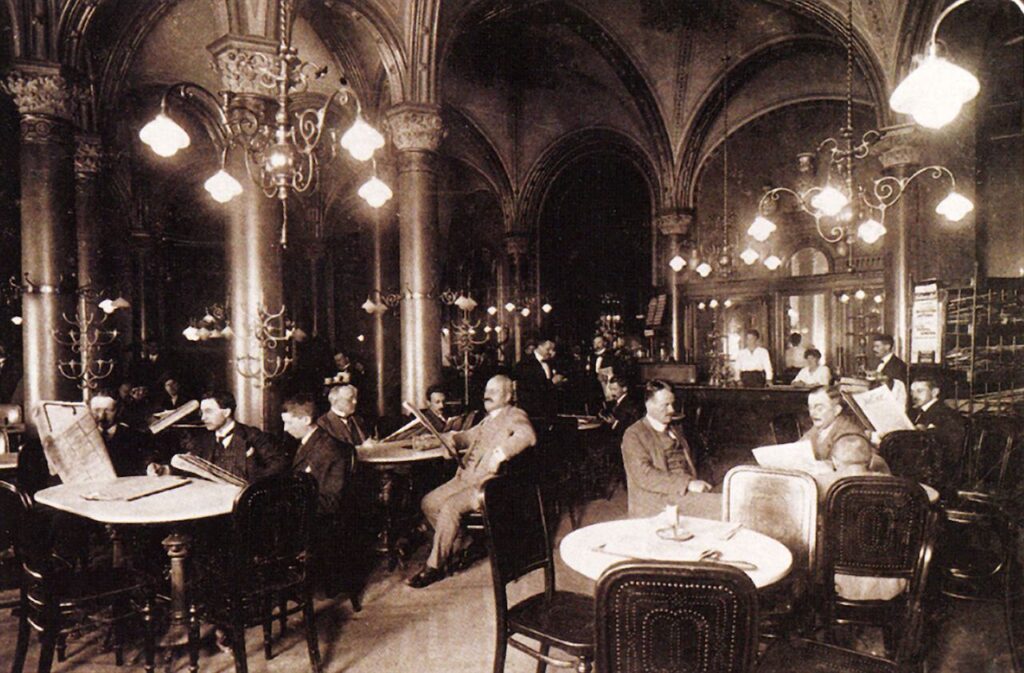
A key characteristic of the creative city (or region or nation) is that it has a certain tolerance toward dissenting views. The reason why this is so important is that creativity technically merges disparate ideas into something new. If there is a bigger chance that you bump into a different opinion – as was the case in the Viennese coffeehouse, for example – there is also a bigger chance that you will be inspired and change your own view. Having a free public debate and being a melting pot of ideas, makes a city more flexible in its thinking and therefore potentially more innovative. You can actually compare this simple mechanism to the importance of the bio-diversity of our natural habitat. With more species around, nature is more flexible and better able to adapt to a changing environment.
The European values democracy, freedom and equality are a natural breeding ground for creativity
If there is one thing we can learn from Florence, Athens and Vienna, it is that the European values democracy, freedom and equality form a natural breeding ground for creativity. These values give access to, specialize and innovate our knowledge, which feeds into our creative ideas. And these ideas, in turn, are the starting point for innovation. Today, Europe still has a great diversity of cultures within a single continent. While its single market at the same time allows the free movement of persons, goods and capital, forming the ideal lubricant to connect our disparate European ideas. Other EU-measures, such as abolishing mobile roaming charges in 2017 or the brand new Open Access plan, providing free online access to scholarly publications, also facilitate the interaction between ideas. By combining the best of both worlds – great diversity and the free flow of ideas – Europe potentially has a much richer breeding ground for innovation than China and the US.
Venture capital that crosses borders
So why is it that the EU can’t produce as many start-ups as Silicon Valley? One of the reasons is that there is a lack of venture capital. Having creative ideas is one thing, but transforming these ideas into innovations is a lengthy process of trial and error. This process requires capital. For Florence money was not an issue. Despite its modest size during the Renaissance, the town counted no less than 80 banks. The money in these banks, accumulated through trading, was heavily invested in the arts. The richest families of Florence – such as the famous Medicis – believed in art, as Silicon Valley’s venture capital believes in tech. As Plato said: What is honoured in a country, will be cultivated there.
Because venture capital is crucial, it is good news that Von der Leyen’s Green Deal also plans for the EIB (the EU’s lending arm) to dedicate half its financing to climate investment by 2025. On top of that, she is introducing a ‘Sustainable Europe Investment Plan’ with a trillion euros (€1,000 billion!) in investment over the coming decade. At least as important, however, is an abundance of private venture capital that can easily cross borders. The reason is that private venture capital doesn’t have to be politically correct and doesn’t have a vested interest in the status quo. If, for example, the EU would invest in cultured meat (a revolutionary invention that solves every negative of the existing meat industry), it would discredit the existing meat industry that is heavily subsidized by that same EU. Venture capital therefore more objectively and smartly finds its way. In any case, the overal message here is that only with enough cross-border venture capital Europe’s startup potential will be more than the sum of its parts.
A metaphor for how badly Europe has innovated across borders in the past century, is its inefficient train network. Once you cross a border by train any efficiency or improvement made locally instantly disappears. For example, last year I found out that taking the train to Copenhagen from Amsterdam will take a full day – with 5 (!) transfers if you leave at a bad time. Flying takes less than one and a half hours and is substantially cheaper. Local measures to induce train travel, such as Germany dropping its train fares for long-distance rail-travel with 10%, are welcome of course, but not radical enough to become a climate-neutral continent.
A true innovation would be Elon Musk’s Hyperloop, a vacuum train that travels with more than a thousand kilometres an hour
When it comes to efficient and clean pan-European travel, a true innovation would be Elon Musk’s Hyperloop, a vacuum train that is faster than a plane, but uses less than 10% of its energy. It allows you to travel from Amsterdam to Frankfurt in 50 minutes – instead of the current 4.5 hours by normal train. This concept would instantly turn air travel within Europe into an inferior means of transportation. So, if Europe wants to take strides in becoming climate-neutral, it should (financially) facilitate a company like Hardt, which is developing a hyperloop-system for Europe. That would be significantly more effective than invoking a kerosene tax on air travel – as the EU plans to do.
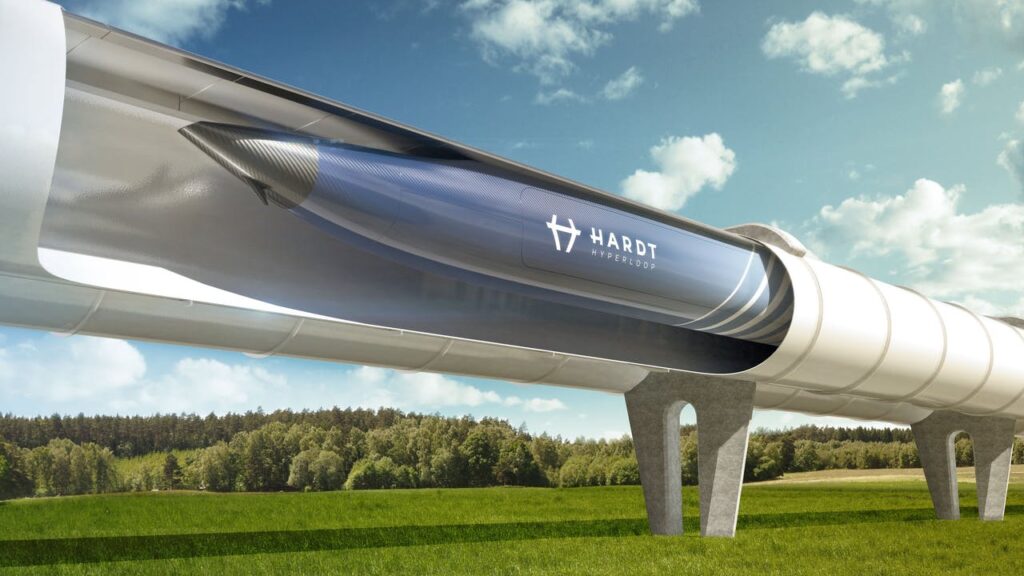
An economy inspired by a donut
Besides creating a climate where startups can grow, another fundamental question to be answered is what kind of value innovation should add to the European economy. According to the old model, the value of our market is defined by things like ‘size’ (in terms of GDP) and ‘growth’. Based on these indicators many economists are sad about Brexit; the internal market shrinks and its growth is likely to stagnate. Another way of looking at the UK, however, is that of a nation that has always been more interested in the benefits of the EU than its burdens. From this perspective, Brexit will mean one frog less that is constantly frustrating the wheelbarrow’s course. And the same would go for all the EU-members that are mainly interested in the size of our internal market, rather than the principles of having a sound democracy and the rule of law.
If your only goal is economic growth, you could probably like China, in a relatively short time, become the largest exporter of solar panels, wind turbines, batteries and electric vehicles. But this also means that you see your citizens merely as tiny cogs that keep the economy going; workers and consumers who don’t really care about things like freedom, democracy, equality and human rights. That other great world power, the United States, shows greater resembles with Europe when it comes to its fundamental values, but this neo-liberal nation is governed by multi-millionaires, who are largely owned by corporate America. Regardless their propaganda, the one thing China and the US have in common is that their economic power is more important than the well-being of the average citizen.
Another element in the Green Deal that sounds promising is that it aims to reconcile the European economy with the planet and make it work for its people
In this context, another element in the Green Deal that sounds promising is that it aims to reconcile the European economy with the planet and make it work for its people. Which means, Von der Leyen explained, a growth model that gives more back than it takes away. This sounds like the donut-model invented by Oxford-economist Kate Raworth, which measures our well-being by the realisation of an ecological ceiling on the outside of the donut and a social foundation on the inside. In between you create a safe and just space for the citizens, where things like housing, food, health, education and jobs are guaranteed.
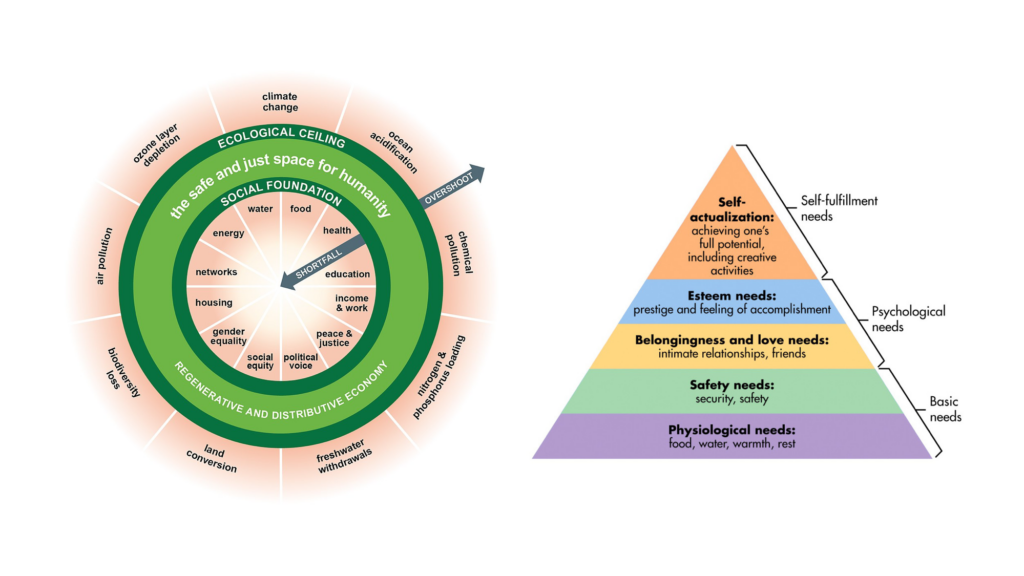
In my opinion, another important element that would contribute to the EU’s social intentions, is the power of self-actualization – sitting at the top of Maslow’s pyramid of human needs. The reason is that this value invites the EU’s citizens to follow their intrinsic motivation, deepen their knowledge and realize their dreams. It will stimulate our creative explorations – and eventually our innovations. An idea that is not merely romantic, but essential in a world where self-learning robots will take over all of our simple, repetitive tasks in the future. In an AI-driven, robotic world, mankind’s added value won’t be labour anymore, it will be creativity.
Changing into smaller wheelbarrow
Despite Von der Leyen’s visionary plan that is clearly aiming for the stars, there is one important element that is likely to frustrate an actual landing on the moon. And that is the fact that even after Brexit, 27 frogs in a wheelbarrow won’t get us very far. If the EU really wants to lead the next industrial revolution, it should stop focusing on size. Instead, it should allow itself to reform into a smaller wheelbarrow. One that is only filled with member-states that unconditionally support the European values and its vision for the future. This Union might have an economy that is smaller, but it will be much more decisive, and its ability to ambitiously innovate will increase inversely.
Naivety is an asset, not a burden, when you want to become the first climate-neutral continent in the world
Many bureaucrats in Brussels will probably judge this idea to be rather naïve. But naivety is a crucial ingredient for radical innovation. It’s the ingredient that enables you to reform yourself, without being deterred by the rules that define the status quo. Naivety is an asset, not a burden, when you want to become the first climate-neutral continent in the world. So, if the EU wants to elevate Von der Leyen’s visionary Green Deal beyond something that through endless negotiations will be dressed down into an average accomplishment, it should break out of its political and economic straightjacket and dare to think like a startup again.


